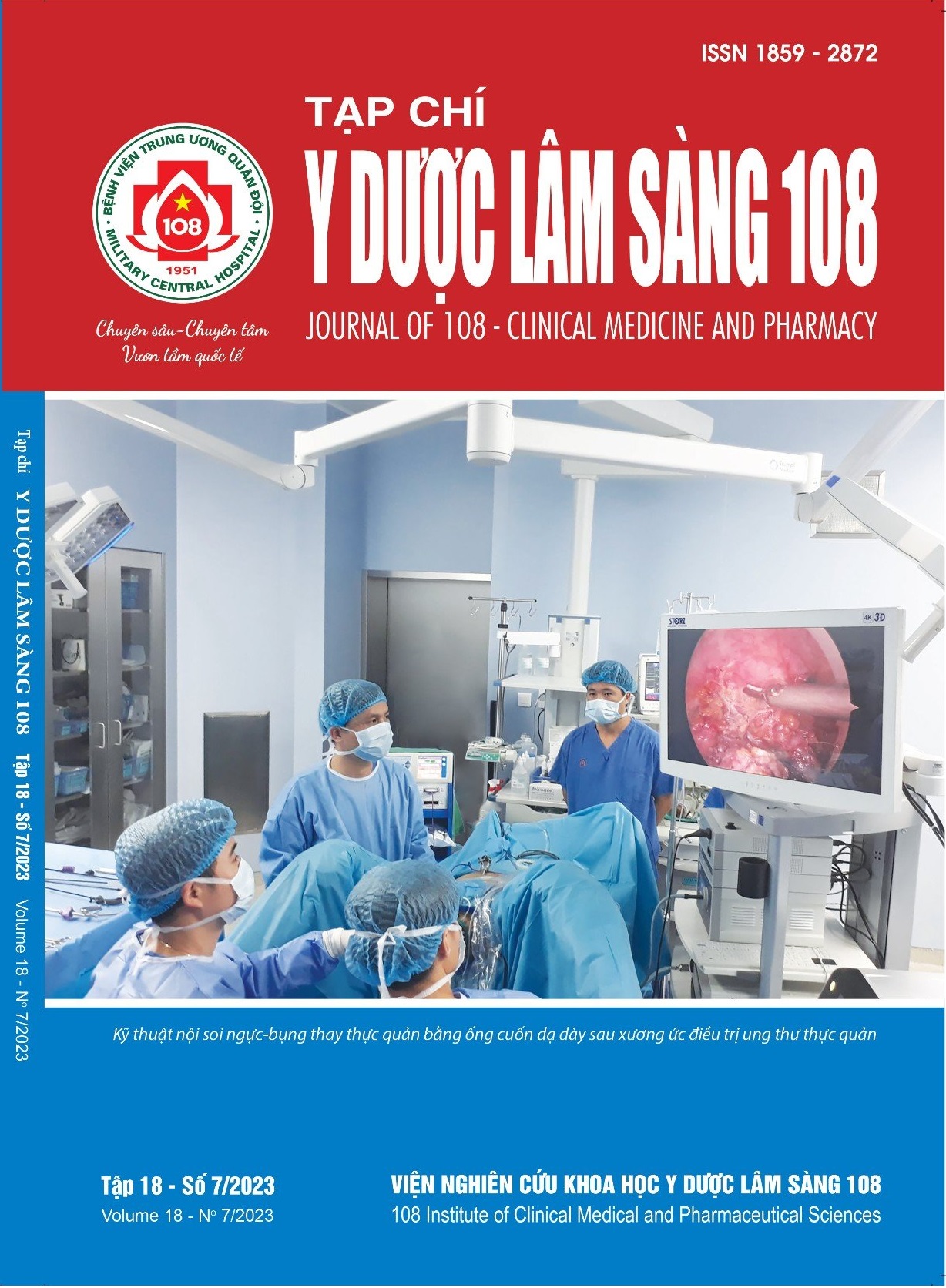Bacteroides fragilis infection may be associated with colorectal cancer
Main Article Content
Keywords
Abstract
Objective: To determine the association between B. fragilis and colorectal cancer. Subject and method: 192 patients with polyp or colorectal cancer at different stages treated at 108 Military Central Hospital from May 2017 to December 2020 were recruited into the current cross-sectional study. The infection rate and relative load of B. fragilis were determined in colon tissues according to stages of infection by realtime PCR. Result: The infection rate of B. fragilis in cancer colon tissue (71.2%) was higher than that in the polyp group (34%). The relative load of B. fragilis (0.09 ± 0.27) in the cancer group was 9 times higher than that in the polyp group (0.01 ± 0.03). The relative load of B. fragilis in malignant tissues was higher than that in adjacent benign tissues in stages II and III of cancer (p<0.05). The relative load of B. fragilis increased gradually with the progression of the colorectal cancer stages. Colorectal cancer group had a 3.2 times higher risk of F. nucleatum infection than benign polyp group (CI 95%: 1.7 -14.1, p=0.003). Conclusion: B. fragilis infection may be associated with colorectal cancer.
Article Details
References
2. Long AG, Lundsmith ET, and Hamilton KE (2017) Inflammation and colorectal cancer. Curr Colorectal Cancer Rep 13(4): 341-351.
3. Grivennikov SI, Greten FR, and Karin M (2010) Immunity, inflammation, and cancer. Cell 140(6): 883-899.
4. Sandouk F, Al Jerf F, Al-Halabi MH (2013) Precancerous lesions in colorectal cancer. Gastroenterol Res Pract: 457901.
5. Shalapour S and Karin M (2015) Immunity, inflammation, and cancer: An eternal fight between good and evil. J Clin Invest 125(9): 3347-3355.
6. Guinane CM and Cotter PD (2013) Role of the gut microbiota in health and chronic gastrointestinal disease: Understanding a hidden metabolic organ. Therap Adv Gastroenterol 6(4): 295-308.
7. Hansson GC (2012) Role of mucus layers in gut infection and inflammation. Curr Opin Microbiol 15(1): 57-62.
8. Ellermann M and Sartor RB Intestinal bacterial biofilms modulate mucosal immune responses. J Immunol Sci 2(2): 13-18.
9. Zamani S, Taslimi R, Sarabi A, Jasemi S, Sechi LA, Feizabadi MM (2019) Enterotoxigenic Bacteroides fragilis: A possible etiological candidate for bacterially-induced colorectal precancerous and cancerous lesions. Front Cell Infect Microbiol: 449.
10. Wexler HM (2007) Bacteroides: The good, the bad, and the nitty-gritty. Clin Microbiol Rev 20(4): 593-621.
11. Frederick M, Ausubel RB, Robert E Kingston, David D Moore, Seidman JG, John A Smith KS (2003) Current Protocols in Molecular Biology: 66.
12. Papaparaskevas J, Mela V, Houhoula DP, Pantazatou A, Petrikkos GL, Tsakris A (2013) Comparative evaluation of conventional and real-time PCR assays for detecting Bacteroides fragilis in clinical samples. J Clin Microbiol 51(5): 1593-1595.
13. Sogin ML, Morrison HG, Huber JA, Mark Welch D, Huse SM, Neal PR, Arrieta JM, Herndl GJ (2006) Microbial diversity in the deep sea and the underexplored "rare biosphere". Proc Natl Acad Sci U S A 103(32): 12115-12120.
14. Bodenhausen N, Horton MW, and Bergelson J (2013) Bacterial communities associated with the leaves and the roots of Arabidopsis thaliana. PLoS One 8(2): 56329.
15. Wu YD, Chen LH, Wu XJ, Shang SQ, Lou JT, Du LZ, Zhao ZY (2008) Gram stain-specific-probe-based real-time PCR for diagnosis and discrimination of bacterial neonatal sepsis. J Clin Microbiol 46(8): 2613-2619.
16. Dejea CM, Fathi P, Craig JM, Boleij A, Taddese R, Geis AL, Wu X, DeStefano Shields CE, Hechenbleikner EM, Huso DL, Anders RA, Giardiello FM, Wick EC, Wang H, Wu S, Pardoll DM, Housseau F, Sears CL (2018) Patients with familial adenomatous polyposis harbor colonic biofilms containing tumorigenic bacteria. Science 359(6375): 592-597.
17. Sears CL (2009) Enterotoxigenic Bacteroides fragilis: A rogue among symbiotes. Clin Microbiol Rev 22(2): 349-69, Table of Contents.
18. Spigaglia P, Barbanti F, Germinario EAP, Criscuolo EM, Bruno G, Sanchez-Mete L, Porowska B, Stigliano V, Accarpio F, Oddi A, Zingale I, Rossi S, De Angelis R, Fabbri A (2023) Comparison of microbiological profile of enterotoxigenic Bacteroides fragilis (ETBF) isolates from subjects with colorectal cancer (CRC) or intestinal pre-cancerous lesions versus healthy individuals and evaluation of environmental factors involved in intestinal dysbiosis. Anaerobe 82: 102757.
19. Khodaverdi N, Zeighami H, Jalilvand A, Haghi F, Hesami N (2021) High frequency of enterotoxigenic Bacteroides fragilis and Enterococcus faecalis in the paraffin-embedded tissues of Iranian colorectal cancer patients. BMC Cancer 21(1): 1353.
20. Shariati A, Razavi S, Ghaznavi-Rad E, Jahanbin B, Akbari A, Norzaee S, Darban-Sarokhalil D (2021) Association between colorectal cancer and Fusobacterium nucleatum and Bacteroides fragilis bacteria in Iranian patients: A preliminary study. Infect Agent Cancer 16(1): 41.
 ISSN: 1859 - 2872
ISSN: 1859 - 2872
